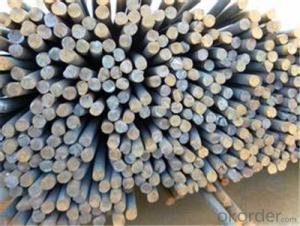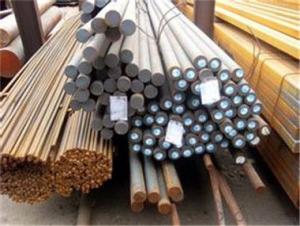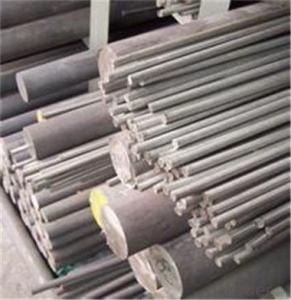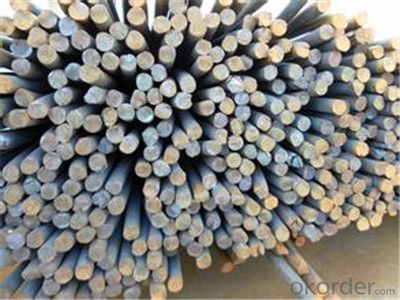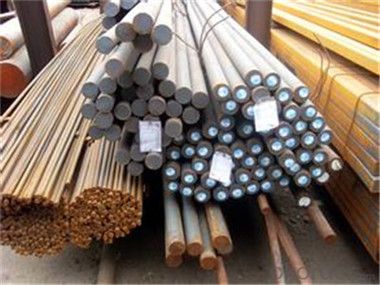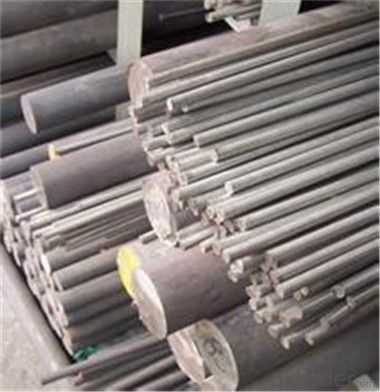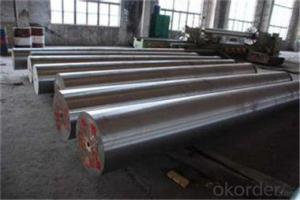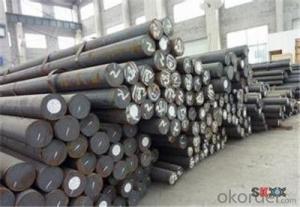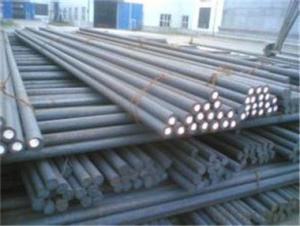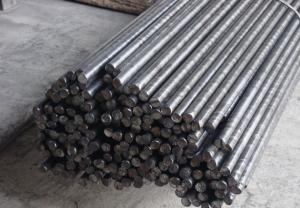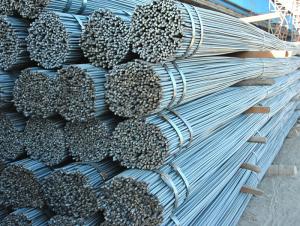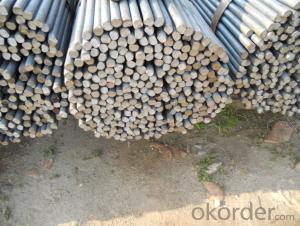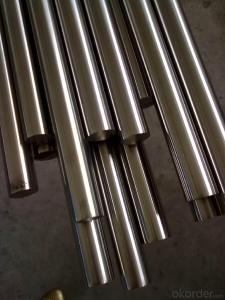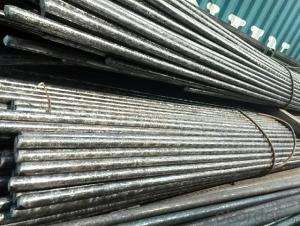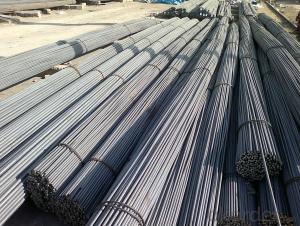Steel Round Bar Reliable Manufacturer with Good Quality
- Loading Port:
- Tianjin
- Payment Terms:
- TT OR LC
- Min Order Qty:
- 20 m.t.
- Supply Capability:
- 2000000 m.t./month
OKorder Service Pledge
OKorder Financial Service
You Might Also Like
Specification
Description of steel round bar:
1.Diameter 80 to 800 mm
2.Black or Bright surface
3.Annealed or Quenched and tempered provided
4.Cutting service provide
Festures of steel round bar:
4340 Forged Round Steel Bar
1.Dia 80-800mm Length:2000-13000mm or as required
2.Technique:Forged
Cold work tools
Cutting and pressing tools
Cavity moulds
Measuring tools
Stamping tools
Deep drawing tools and presses
Industrial shears
Specifications of steel round bar:
1. Standards: AISI 4340 8620 8640 4320 , JIS SNCM8 GB:40CrNiMoA
2. Specification: Dia: 80~450mm Length:2000-13000mm or as required
3. Process: EAF+LF+VD ( necessary) UT+ Peeled +Turned + Heat Treatment (optional)
4. Chemical Composition (%):
C | Si | Mn | S | P | Cr | Ni | Cu | Mo |
0.37-0.44 | 0.17-0.37 | 0.40-0.80 | 0.025(max) | 0.025(max) | 0.60-0.90 | 1.25-1.65 | 0.025(max) | 0.15-0.25 |
Images of steel round bar:
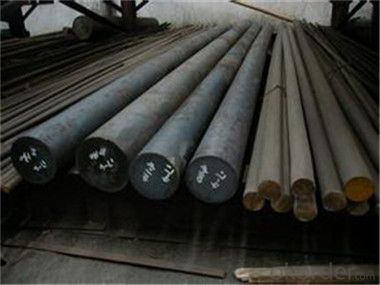
FAQ:
1. What is your package?
Packing situation: standard seaworthy packing or as customer required.
2. How long is the lead time?
Delivery time: 45 days after order confirmed.
3. What payment term do you accept?
Payment: T/T or L/C at sight.
- Q: Can steel round bars be used for making gears or sprockets?
- Yes, steel round bars can be used for making gears or sprockets. Steel is a commonly used material for gears and sprockets due to its strength, durability, and ability to withstand high loads and friction. The round bars can be machined or shaped into the desired gear or sprocket design, providing a reliable and efficient solution for various applications.
- Q: Are steel round bars prone to deformation?
- When steel round bars are manufactured and used correctly, they usually do not deform. Steel is recognized for its strong tensile strength and durability, which means it can resist bending or warping in normal situations. However, it is essential to remember that excessive force or mishandling can still lead to deformation in steel round bars. Overloading, improper storage, or using inappropriate machining techniques can all contribute to the bars bending or twisting. Hence, it is vital to adhere to recommended guidelines and industry standards to guarantee the durability and longevity of steel round bars.
- Q: What are the different surface defects that can be found in steel round bars?
- There are several surface defects that can be found in steel round bars. These defects can vary in severity and can have an impact on the overall quality and performance of the steel. Some common surface defects include: 1. Scale: Scale refers to the thin, flaky layer of iron oxide that forms on the surface of steel during the manufacturing process. It can appear as a rough, scaly texture and may cause issues with adhesion or coating application. 2. Pitting: Pitting is the formation of small holes or depressions on the surface of the steel. It can be caused by corrosion, contamination, or uneven heating during the manufacturing process. Pitting can weaken the structural integrity of the steel and increase the likelihood of failure. 3. Scratches: Scratches are superficial marks or cuts on the surface of the steel. They can occur during handling, transportation, or processing. While small scratches may not significantly affect the performance of the steel, deep or extensive scratches can create stress concentrations and reduce the strength of the material. 4. Cracks: Cracks are linear fractures that can occur on the surface of the steel. They can be caused by excessive cooling, improper heat treatment, or mechanical stress. Cracks can propagate and lead to catastrophic failure if not detected and addressed. 5. Decarburization: Decarburization is the loss of carbon content on the surface of the steel due to exposure to high temperatures or improper heat treatment. It can result in a softer and weaker surface layer, reducing the material's strength and hardness. 6. Laminations: Laminations are layers or separations within the steel round bar that can occur due to improper rolling or manufacturing processes. These can weaken the material and reduce its load-bearing capacity. 7. Inclusions: Inclusions are non-metallic impurities or foreign substances that are trapped within the steel during the manufacturing process. They can include oxides, sulfides, or other debris. Inclusions can act as stress concentrators and reduce the material's resistance to cracking and deformation. Detecting and addressing these surface defects is crucial to ensure the quality and reliability of steel round bars. Various inspection techniques such as visual examination, ultrasonic testing, magnetic particle testing, or dye penetrant testing can be employed to identify and assess the severity of these defects.
- Q: Can steel round bars be used for making sculptures?
- Yes, steel round bars can be used for making sculptures. Steel is a versatile and durable material that can be manipulated into various forms and shapes. Round bars are particularly suitable for creating sculptures that require a smooth and curved aesthetic. Steel sculptures are known for their strength, longevity, and ability to withstand different weather conditions, making them suitable for both indoor and outdoor installations. Additionally, steel can be welded, bent, and shaped easily, allowing artists to explore their creativity and create intricate designs. With proper techniques and skills, steel round bars can be transformed into stunning sculptures that can add a modern and industrial touch to any space.
- Q: What are the different surface treatments available for stainless steel round bars?
- To enhance the appearance, improve corrosion resistance, and provide added protection for stainless steel round bars, there are various surface treatments available. Some commonly used surface treatments for stainless steel round bars are as follows: 1. Acid immersion: This process involves immersing the stainless steel bar in an acid solution to eliminate surface impurities and oxides. Acid immersion restores the natural corrosion resistance of stainless steel and results in a smooth and clean surface. 2. Chemical passivation: Passivation is a chemical treatment that forms a thin, protective layer on the surface of stainless steel. By eliminating free iron and other contaminants, passivation enhances the corrosion resistance of stainless steel. 3. Electrolytic polishing: This treatment involves immersing the stainless steel round bar in an electrolyte solution and applying an electric current. By removing a thin layer of material from the surface, electrolytic polishing creates a smooth, shiny, and corrosion-resistant finish. 4. Mechanical grinding and polishing: Grinding and polishing are mechanical processes used to improve the surface finish of stainless steel round bars. Grinding eliminates imperfections and roughness, while polishing creates a smooth and reflective surface. 5. Protective coating: Applying a protective layer to stainless steel round bars can provide additional corrosion resistance. Common coatings include electroplating with zinc or nickel, as well as organic coatings such as paints or powder coatings. 6. High-velocity shot blasting: This treatment involves bombarding the surface of the stainless steel round bar with small metallic or non-metallic particles at high speed. Shot blasting eliminates surface contaminants, scales, or oxides, resulting in a clean and textured surface. It is important to consider the desired end-use application and specific requirements for appearance and corrosion resistance when choosing a surface treatment for stainless steel round bars. Seeking advice from professionals or manufacturers can help determine the most suitable treatment.
- Q: How do steel round bars compare to stainless steel round bars?
- Steel round bars and stainless steel round bars differ in their composition, making them suitable for various applications. The composition of steel mainly consists of iron with small amounts of carbon and other elements, whereas stainless steel is an alloy composed of iron, chromium, and often other elements like nickel or molybdenum. This unique composition gives stainless steel its distinctive properties, such as corrosion resistance. Both steel and stainless steel round bars can be manufactured to have high tensile strength. However, stainless steel generally has higher tensile strength compared to regular steel, making it more suitable for applications requiring additional strength and durability. Another significant difference lies in their resistance to corrosion. Stainless steel round bars have excellent corrosion resistance due to the presence of chromium in their composition, making them ideal for applications exposed to moisture, chemicals, or other corrosive environments. On the other hand, steel round bars are more prone to rust and corrosion and may need additional protective coatings in such environments. In terms of cost, steel round bars are generally more affordable compared to stainless steel round bars. The higher cost of stainless steel is attributed to its unique properties and the additional alloying elements required in its production. Both steel and stainless steel round bars have advantages and specific applications. Steel round bars are commonly used in construction, manufacturing, and general-purpose applications where corrosion resistance is not a primary concern. In contrast, stainless steel round bars find extensive use in industries such as food processing, chemical processing, medical equipment, and marine applications where corrosion resistance is crucial. In conclusion, the choice between steel round bars and stainless steel round bars depends on the specific requirements of the application. Steel round bars are more cost-effective but may require additional corrosion protection, while stainless steel round bars offer superior corrosion resistance and strength.
- Q: What is the maximum sulfur content allowed for steel round bars?
- The maximum sulfur content allowed for steel round bars typically depends on the specific grade or standard being followed. However, in general, the maximum sulfur content is often restricted to 0.050% or 0.060% by weight.
- Q: Can steel round bars be used for making tie rods?
- Yes, steel round bars can be used for making tie rods.
- Q: What is the difference between steel and flat steel, round steel and steel?
- In fact, for the processing of raw materials are the same, is used when the roller rolling pressure is not the same, there are many different types of tooth roller shaft, can produce different steel, the steel section is square, round cross section is round
- Q: Can steel round bars be used in the automotive parts industry?
- Yes, steel round bars can be used in the automotive parts industry. Steel round bars are commonly used in the manufacturing of various automotive components due to their excellent strength, durability, and resistance to wear and tear. These bars can be fabricated into different shapes and sizes to meet the specific requirements of automotive parts such as axles, drive shafts, suspension components, steering components, and gears. The use of steel round bars ensures the structural integrity and reliability of automotive parts, making them ideal for withstanding the demanding conditions and loads experienced in the automotive industry.
Send your message to us
Steel Round Bar Reliable Manufacturer with Good Quality
- Loading Port:
- Tianjin
- Payment Terms:
- TT OR LC
- Min Order Qty:
- 20 m.t.
- Supply Capability:
- 2000000 m.t./month
OKorder Service Pledge
OKorder Financial Service
Similar products
Hot products
Hot Searches
Related keywords
